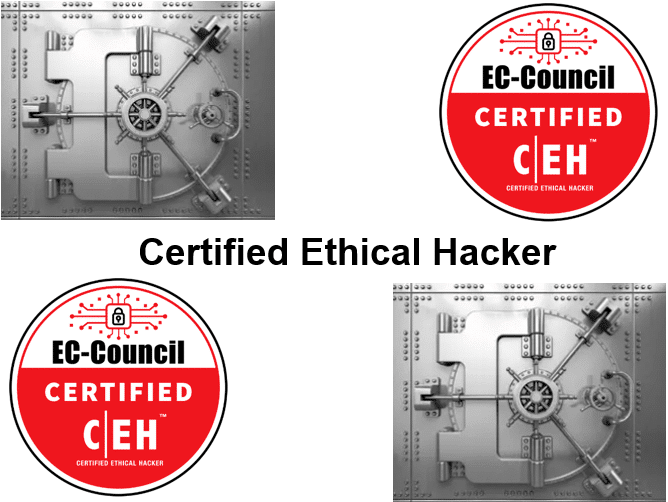-
Learning by doing
-
Trainers with practical experience
-
Classroom training
-
Detailed course material
-
Clear content description
-
Tailormade content possible
-
Training that proceeds
-
Small groups
The course Certified Ethical Hacker covers the basics of information security, the principles of ethical hacking, relevant laws and standard procedures. Afterwards one can certify as Certified Ethical Hacker by taking the exam.
Learn to use the latest techniques to perform foot printing and reconnaissance, a critical phase of the ethical hacking process.
Learn network scanning techniques. Learn various enumeration techniques, such as BGP and NFS exploits.
Learn system hacking methodologies like steganography, steganalysis attacks and tracks—used to discover vulnerabilities.
Learn different types of malware (Trojan, virus, etc.), APT and fileless malware, malware analysis procedure.
Learn to use packet-sniffing techniques to discover network vulnerabilities and to defend against sniffing attacks.
Learn social engineering techniques, including identifying theft attempts and audit human-level vulnerabilities.
Learn about different Denial of Service attack techniques, as well as the tools used to audit and protect a target.
Understand session hijacking techniques to discover network-level session management and SQL Injection attacks.
Get introduced to firewall, intrusion detection system (IDS), and cryptography attacks.
Learn about web server attacks, including attack methodology used to audit vulnerabilities in web server infrastructures.
Understand different types of wireless technologies, including encryption and Wi-Fi security tools.
Learn Mobile platform attack vectors, IoT and OT attacks, mobile device management and mobile security guidelines.
Learn cloud computing concepts and threats, attacks, hacking methodology and cloud security techniques and tools.
The course Certified Ethical Hacker is intended for aspiring cybersecurity professionals who want to learn techniques to find weaknesses in systems before criminals do.
General knowledge of computer systems and security problems is sufficient.
In the course Certified Ethical Hacker participants learn the tools and techniques to investigate networks and systems for security problems through hands-on exercises.
After successfully completing the training, participants will receive a certificate of participation in the course Certified Ethical Hacker. The course meets the requirements for the Certified Ethical Hacker exam of the EC-Council. After the course one can pass this exam with the knowledge gained.

Module 1 : Intro Ethical Hacking |
Module 2 : Foot Prints |
Module 3 : Scanning Networks |
|
Fundamental Security Issues Ethical Hacking Basics Laws and Standard Procedures |
Foot Printing Techniques Reconnaissance Techniques Pre-attack Phase |
Network Scanning Determining Device State Countermeasures |
Module 4 : Enumeration |
Module 5 : Vulnerability Analysis |
Module 6 : System Hacking |
|
Enumeration Techniques Border Gateway Protocol Network File Sharing |
Security Loopholes Vulnerability assessment Assessment Tools |
Hacking Methodologies Steganography Attacks Steganalysis Attacks |
Module 7 : Malware Threats |
Module 8 : Sniffing |
Module 9 : Social Engineering |
|
Malware Threats Malware Analysis Malware Countermeasures. |
Packet-sniffing Techniques Discover Network Vulnerabilities Countermeasures Sniffing Attacks. |
Social Engineering Techniques Identify Theft Attempts Human-level Vulnerabilities |
Module 10 : Denial-of-Service |
Module 11 : Session Hijacking |
Module 12 : Evading IDS and Firewalls |
|
Denial of Service (DoS) Distributed DoS (DDos) Countermeasures and Protections |
Session Hijacking Techniques Authentication and Authorization Cryptographic Weaknesses |
Intrusion Detection System (IDS) Honeypot Evasion Techniques Perimeter for Weaknesses |
Module 13 : Hacking Web Servers |
Module 14 : Hacking Web Apps |
Module 15 : SQL Injection |
|
Web Server Attacks Attack Methodology Audit Vulnerabilities |
Web Application Attacks Vulnerabilities Web Apps Countermeasures |
SQL Injection Attacks Evasion Techniques Injection Countermeasures. |
Module 16 : Hacking Wireless |
Module 17 : Hacking Mobile Platforms |
Module 18 : IoT Hacking |
|
Wireless Technologies Encryption Threats Wi-Fi Security Tools |
Mobile Attack vector Android and iOS Hacking Mobile Security Guidelines |
IoT and OT attacks Hacking Methodology Hacking tools |
Module 19 : Cloud Computing |
Module 20 : Cryptography |
|
|
Container Technologies Server Less Computing Cloud Computing Threats |
Encryption Algorithms Cryptography Tools Cryptography Attacks |
